
Medically Reviewed by: Dr Lindsey Ulin
If you are struggling with breathlessness or have a heart defect, an NHS-approved pulse oximeter is a fantastic way to monitor your health. Having a pulse oximeter at home can provide you and your family with peace of mind, allowing for regular checks at home in between doctor's appointments.
A pulse oximeter is a small, non-invasive health gadget that allows you to monitor the oxygen levels in your blood. The NHS and doctors widely use this medical device to diagnose or monitor lung disease, as well as to monitor patients at home with various respiratory conditions.
Dr Lindsey Ulin, M.D. is a resident physician and primary care provider at Brigham and Women's hospital, and she regularly uses pulse oximeters in her work with patients. She says when it comes to choosing a pulse oximeter, more expensive isn't necessarily better.
"There are many pulse oximeters on the market and you shouldn't feel the need to purchase the more expensive models to get accurate measurements at home. The Medicines and Healthcare Products Regulatory Agency (MHRA) does not approve medical devices like pulse oximeters directly, but you can look for a CE, CE UKNI or UKCA mark on the pulse oximeter to show market approval by an external body. I recommend buying from a credited source, and reading the reviews if you purchase a pulse oximeter online."
Best NHS-approved pulse oximeters at a glance:
• Best overall pulse oximeter: Braun Healthcare Pulse Oximeter - Buy now on Amazon UK
• Best 5-in-1 pulse oximeter: Med Linket Oxygen Saturation Monitor – Buy now on Amazon UK
• Best pulse oximeter battery life: Salter Finger Tip Pulse Oximeter OxyWatch – Buy now on Amazon UK
Home health monitors, such as Fitbit watches, have grown in popularity. These devices offer various features for monitoring well-being and fitness. This information is crucial for assessing respiratory health, and keeping a regular eye on your oxygen levels can be an early indicator of respiratory issues. Whilst pulse oximeters are valuable tools for monitoring oxygen levels, they should not replace professional medical advice; rather, they are a great way to keep an eye on your levels.
We've pulled together a useful guide to the best NHS-approved pulse oximeters plus Lindsey Ulin talks us through how to use one, what the readings mean, and what to look for when buying.
How we tested these oximeters
Members of the Yours team and their family have tried-and-tested these oximeters. We tested these oximeters over an extended period of time to evaluate their accuracy. During every testing, the person using the oximeter was seated, feeling relaxed and had not done any strenuous exercise. We also tested at the same time each day to try and build a consistent picture. We were looking to see how accurate the oximeters are at measuring a regular, resting heart rate – how we normally are, if you will.
We then took these readings and compared them to our own measurements – using the two fingers on wrist or neck pulse, as well as readings picked up on smart watches such as a FitBit or Apple Watch. Read more about how we test.
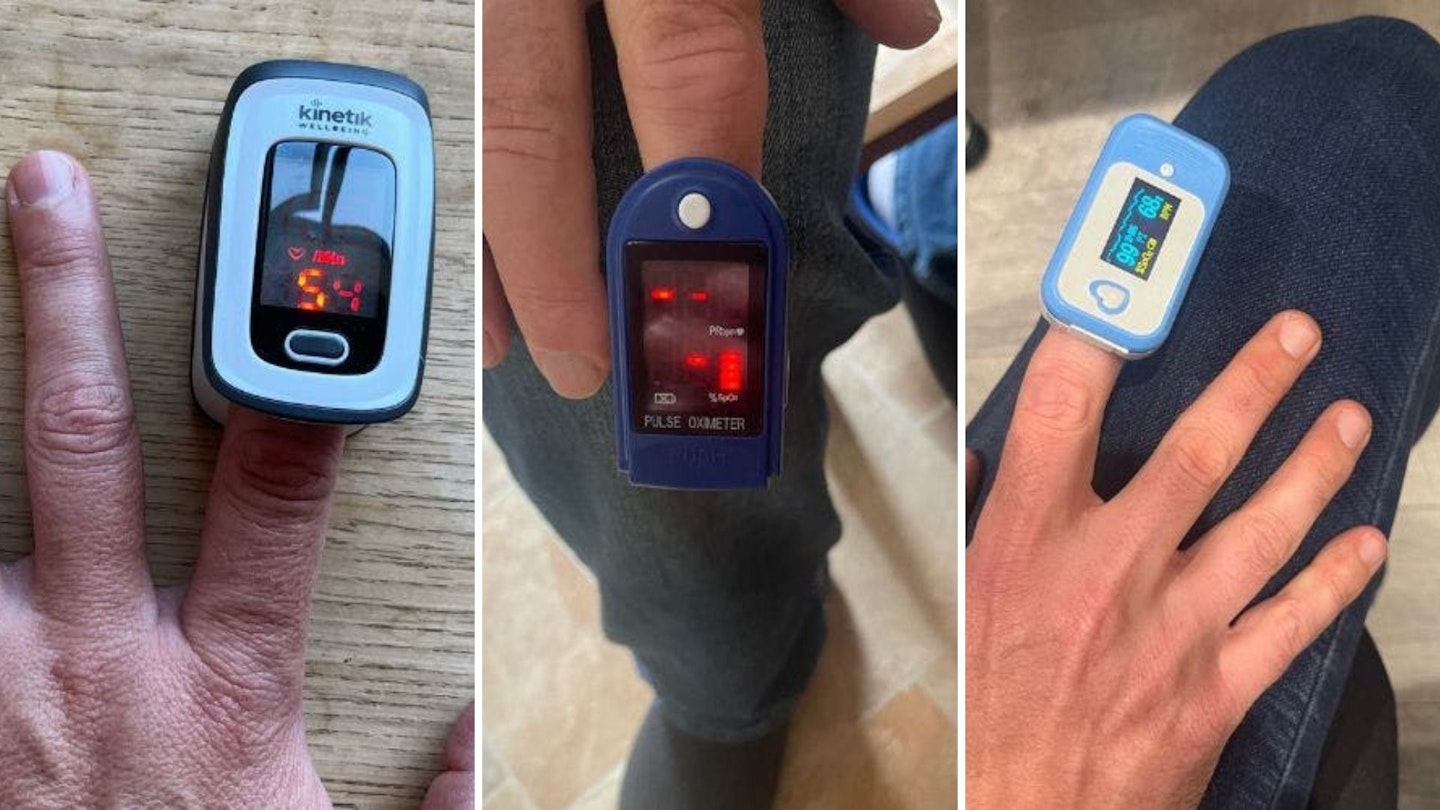
Best NHS-approved pulse oximeters
28% off
Best overall pulse oximeter
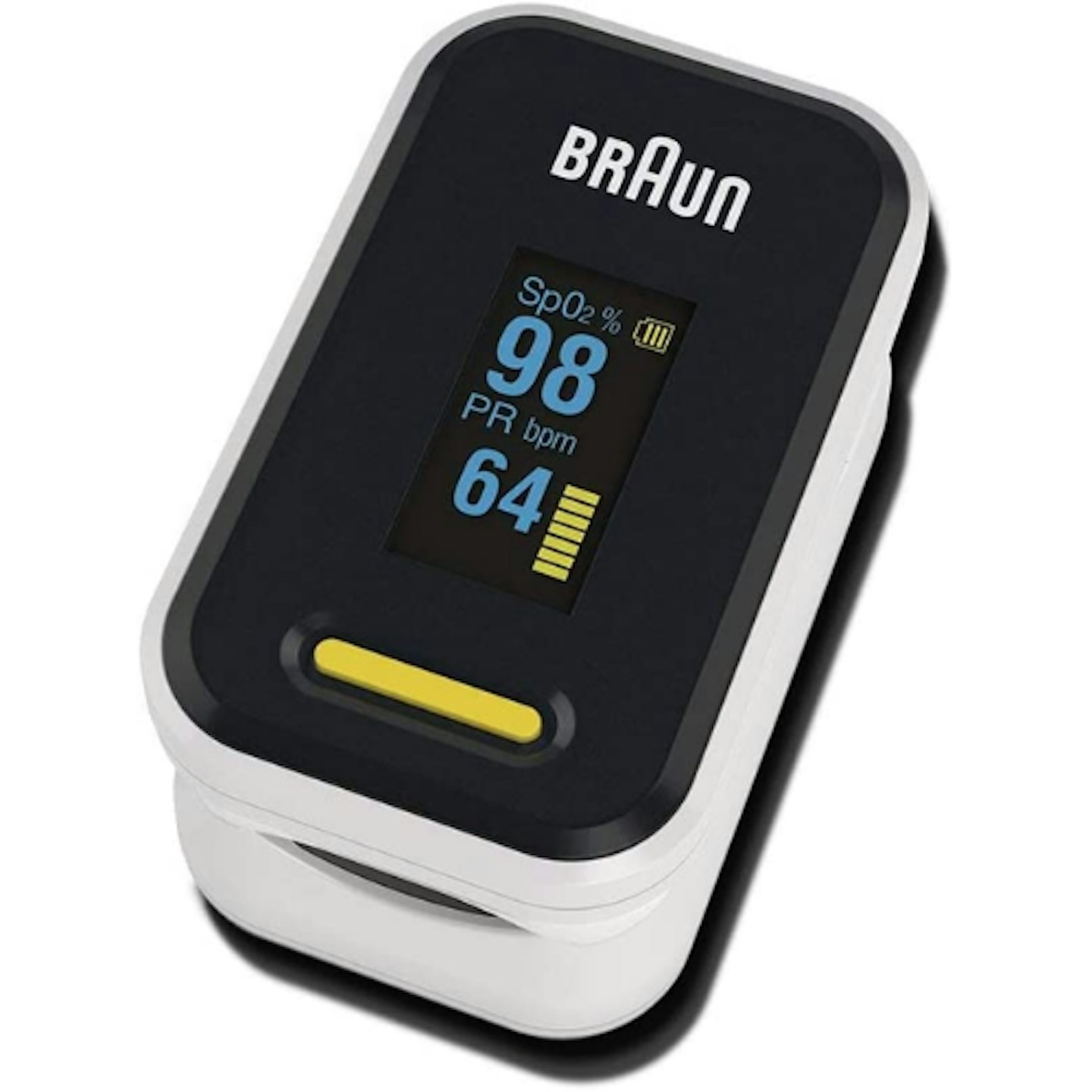 Braun
BraunThe Braun Healthcare Pulse Oximeter is a standout choice for anyone looking to monitor their respiratory health with ease and confidence. Designed for comfort, clarity and convenience, it combines user-friendly features with accurate performance, making it an excellent tool for home use.
The simple single-finger clip design and one-button operation ensure it's easy to use, even for those new to pulse oximeters. One user praised the device’s straightforward design: "It’s compact and easy to carry around, making it convenient for everyday use.” The rotating, backlit display ensures results are easy to read, whether you’re at home or on the go. As another user shared: “Reading the screen is simple, and you can change how the information is displayed at the touch of a button.”
When it comes to accuracy, the Braun pulse oximeter is clinically validated to meet European standards, giving users peace of mind about the reliability of their readings. Many users commented on its consistent performance, with one stating, “I compared results with my GP’s device in surgery during a visit and found the results spot-on with her device.” While some noted it doesn’t have the precision of hospital-grade machines, they acknowledged its value for home monitoring, with one user adding: “Any home use medical equipment is for guidance only.”
Perfect for individuals managing conditions like pneumonia, sleep apnoea and COPD – or for athletes tracking their oxygen levels – the Braun pulse oximeter is a versatile tool. It also includes thoughtful features like an automatic shut-off after eight seconds, preserving battery life, and comes with a lanyard and two AAA batteries.
Users overwhelmingly highlight its comfort and ease of use, with many finding it ideal for everyday health monitoring. In the words of one satisfied customer: “It’s comfortable and easy to use—perfect for quick oxygen level checks.”
For simplicity, accuracy and portability, the Braun pulse oximeter is a reliable choice that empowers users to take control of their health.
Pros
- Clinically validated accuracy
- Rotating, backlit display for easy readability in any setting
- Simple single-finger clip design and one-button operation
- Compact size with lanyard included for convenience
Cons
- Lacks the precision of medical-grade equipment, suitable for guidance only
| SpO2 measurement range: | 80-100% |
| SpO2 accuracy: | +/- 2% |
| PR measurement range: | 25-250bpm |
| Accuracy: | +/- 1bpm |
| Power: | requires two AAA alkaline batteries |
| Dimensions: | 5.8 x 3.5 x 3cm |
TESTED
Best pulse oximeter for battery life
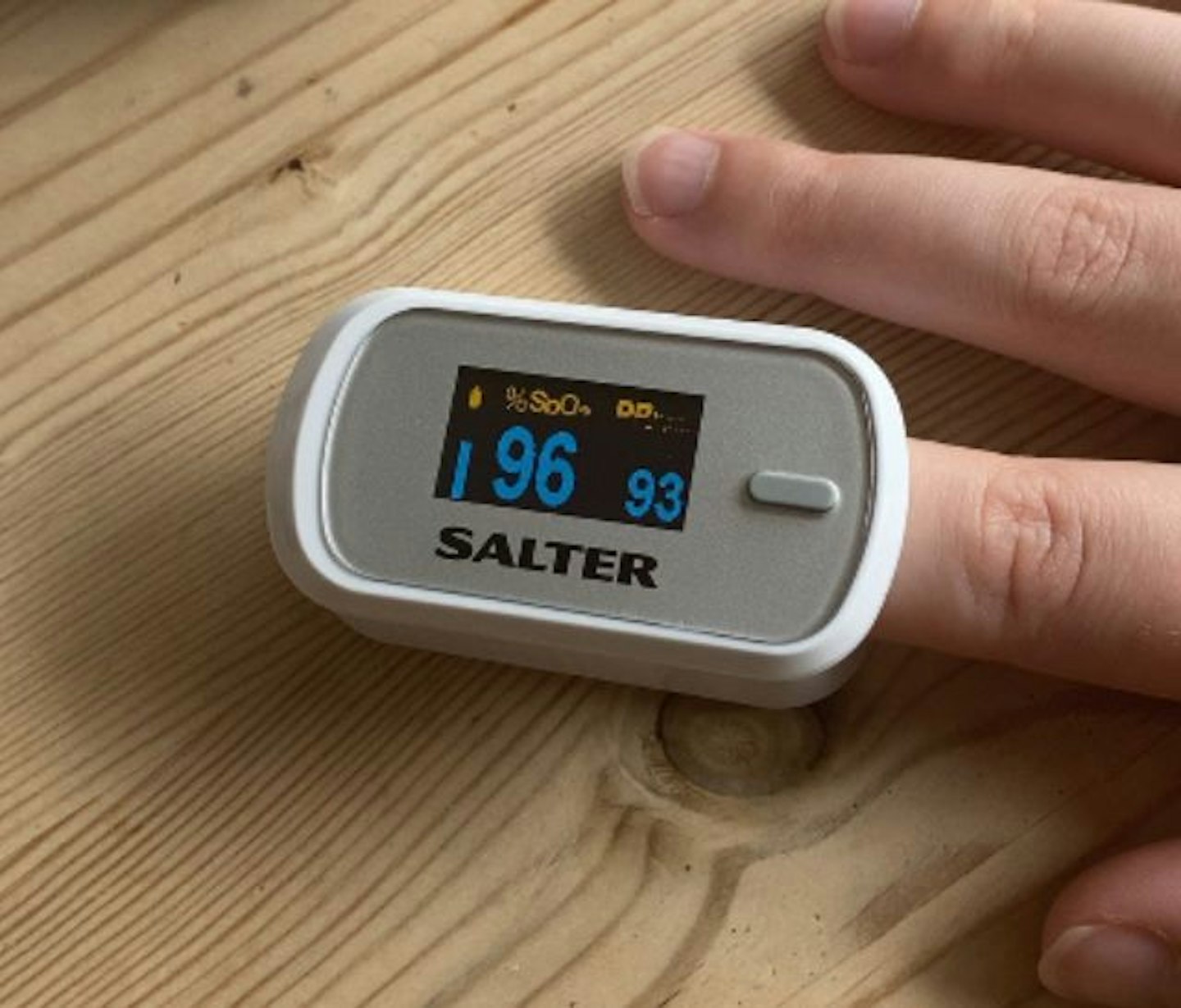 Yours.co.uk/Salter
Yours.co.uk/SalterThe Salter Oximeter "OxyWatch" is packaged in a small, compact box and is ideal for taking on the go with you if you regularly need to check your heart rate and oxygen levels. It also comes with a lanyard, making it both portable and wearable.
I found the setup to be extremely fast, plus batteries are included and you don't need a screwdriver to open the device and add them in. The results are instant - all that’s required is a press of a button once you clip it onto your finger. Plus, it’s not painful at all, as it has a plastic exterior and interior which is smooth on your skin.
Although the OLED screen is rather small, I did not have any issue reading it, although someone who is visually impaired may struggle to. it does have adjustable brightness levels. It's quick and easy to use and you don’t need a smartphone to connect it to, but that being said, it doesn’t store any data from previous readings.
The batteries last for ages and it has a small battery icon on the display to let you know how much power is left. It has a low-power consumption and automatically turns itself off after a few seconds (once you’ve disconnected it from your finger). Over the four weeks of using it everyday, I haven't had to change the batteries, which is important if you need to use this regularly to monitor your health.
Other reviewers have checked its results for accuracy and are pleased: "It has exceeded my expectations in terms of accuracy and reliability. I have tested it against the NHS equivalent within a hospital, giving me the confidence to rely on its readings."
Pros
- Batteries are included
- Automatic power-off function
- Lightweight
- Compact design
Cons
- Small display, which may be tricky to read
| SpO2 measurement range: | 70-100% |
| SpO2 accuracy: | +/- 2% |
| PR measurement range: | 30-250bpm |
| Accuracy: | +/- 2bpm |
| Power: | requires one AAA alkaline battery |
| Dimensions: | 6 x 3.2 x 3cm |
TESTED
If you're looking for a versatile health monitoring device, the Med Linket Oxygen Saturation Monitor stands out with its ability to track five key metrics: SpO2, body temperature, heart rate, perfusion index (blood flow), and plethysmograph (changes in volume, which can help detect issues like blood clots).
Our tester provided a detailed perspective on this oximeter, praising its simplicity and functionality while noting a few drawbacks. They shared: "My first impression of this oximeter was that it looked cheap. I'm not quite sure what I was expecting, though!" Despite the initial impression, the tester was quickly won over by how intuitive the device is: "This was so simple to set up that I didn’t even read the instructions."
The oximeter provides clear and easy-to-read oxygen levels, heart rate and temperature measurements. The included probe must be attached to record temperature, a step that required a quick glance at the instructions: "To record the temperature, you need to plug the probe in, for which I did need to read in the instructions!"
One feature we love is the anti-shake technology, which ensures accurate readings even for users with trembling hands or active children. This device has also been tested across different skin tones and age groups, as our tester highlighted: "The oximeter gives a quick and accurate reading, is suitable for anyone over three years old and caters to any skin colour." This is particularly important given concerns about the accuracy of pulse oximeters on non-white patients.
The device also features built-in alarms for abnormal oxygen levels or temperature readings, making it a handy tool for monitoring health at home. And if you struggle with cold hands or poor circulation, the oximeter's low perfusion technology ensures reliable readings even under these conditions.
However, there are a couple of caveats. The device requires two AAA batteries, which are not included—a slight disappointment for a product in the £30 price range. Additionally, it doesn’t store information. Another note from the tester: "This product will not work as well if the user has artificial nails."
The overall verdict? This pulse oximeter is a solid choice for accurate and easy health monitoring. While there are minor inconveniences, such as the lack of included batteries and the inability to store readings, the range of features and overall reliability make it a worthwhile investment. As our tester summed up: "There was no pain when using this product, and an alarm will sound if you have abnormal oxygen levels."
Whether you're keeping tabs on your health or simply want a reliable device for occasional checks, the Med Linket Oxygen Saturation Monitor offers peace of mind with its clinically tested design.
Pros
- Tracks five key body metrics
- Alarm for abnormal O2 level readings
- Simple and intuitive to set up
- Anti-shake technology for accurate readings, even with trembling hands
- Tested for accuracy across different skin tones and age groups
- Low perfusion technology ensures reliable readings even for cold hands
Cons
- Requires two AAA batteries, which are not included
- The thermometer can be a bit fiddly to use
| SpO2 measurement range: | 70-100% |
| SpO2 accuracy: | +/- 2-3% |
| PR measurement range: | 25-250bpm |
| Accuracy: | +/- 3bpm |
| Power: | requires two AAA alkaline batteries |
| Dimensions: | 6.1 x 3.1 x 3.4cm |
TESTED - 33% off
If you’re looking for a reliable, easy-to-use pulse oximeter for overnight monitoring, the Kinetik Finger Pulse Oximeter stands out as a top choice. Trusted by NHS Scotland and used in partnership with St John Ambulance, it offers clinically validated accuracy in measuring SpO2 and pulse rate. It’s also designed for extended use, operating continuously for more than 30 hours, making it ideal for overnight monitoring or long-term use.
Setting up this device couldn’t be simpler. Our tester noted: "This was really easy to set up and use. Although it said to insert batteries, it actually already had some." The unit comes with a single switch for operation, and the bright display ensures clear and quick readings. As our tester shared, "it only takes a few seconds for the reading to appear. I found it was best to sit still for a moment more to make sure the reading had settled properly."
Accuracy is a standout feature of the Kinetik Oximeter. Our tester also tried it on their adult daughter, comparing the results to smartwatch readings. They remarked: "They were both accurate to each other within one beat, so I’d say it’s an accurate pulse reader."
A lanyard is included, making it easy to carry for those with health concerns who may need quick access to their readings. "This also comes with a strap so you can keep it on you," the tester noted, highlighting its portability.
For the most part, users praise the accuracy and simplicity of the Kinetik Oximeter, but it’s worth noting that cold fingers can affect readings. As one user discovered: "I was getting unreliable readings and realised this was due to my fingers being too cold… So now, I make sure to swing my arms about to get some blood in my fingers and warm them up first."
In conclusion, the Kinetik Finger Pulse Oximeter is a reliable, user-friendly device with clinically validated accuracy. Its extended battery life, portability and association with trusted healthcare organisations make it a great choice for overnight monitoring. Whether you’re monitoring for medical reasons, fitness or simply peace of mind, this oximeter delivers clear and accurate results every time.
Pros
- Clinically validated and used by NHS Scotland and St John Ambulance
- Easy to use and has a large and clear display
- 30+ hours of continuous use, ideal for overnight or long-term monitoring
- Portable design with an included lanyard for convenience
- Battery pre-installed, ready to use out of the box
Cons
- Cold fingers may affect readings
| SpO2 measurement range: | 0-100% |
| SpO2 accuracy: | 70%-100%; ±2% |
| PR measurement range: | 30-250 bpm |
| Accuracy: | ±2bpm or ±2% select larger |
| Power: | 2 x AAA batteries required (included) |
| Dimensions: | 5.7 x 3.1 x 3.2cm |
TESTED
Best oximeter for an on-the-spot reading
 Yours.co.uk/Anapulse
Yours.co.uk/AnapulseThe Anapulse 100 Finger Pulse Oximeter offers a range of features that make it a top choice for both healthcare professionals and home users looking to regularly monitor their oxygen levels and heart rate. On the device's user-friendly design, our tester says: "I’m not the most tech-savvy, but the Anapulse 100 Oximeter was surprisingly simple to set up." Our tester also appreciated how easy the results were to read, being legible even to individuals with slight visual impairment. The digital display provides clear, easy-to-read heart rate and oxygen level readings, even in low ambient light, thanks to its bright LED screen.
Weighing just 50g, this portable oximeter can easily be carried in your pocket, making it a convenient tool for on-the-go testing. Whether you're at home, at work or travelling, the Anapulse 100 ensures you can monitor your health anytime. Our tester appreciated its portability: "It is very comfortable to wear and is battery-operated, meaning you can take it on the go," she explained. With the auto power-off function, it conserves battery life by switching off when the finger is removed for more than five seconds. Plus, the included carrying case and lanyard make it easy to keep your oximeter handy whenever you need it.
While our tester admitted the device might seem a bit pricey compared to other models, she quickly saw the value in its performance. "It may seem expensive for what it is, as there are cheaper alternatives, but they might not perform the same." The Anapulse 100 offered solid performance, with a battery life that lasts over 24 hours with continuous use. Our tester also liked the clip feature that allowed her to attach it to her belt easily, something she felt might not be possible with cheaper alternatives.
One downside our tester pointed out was the lack of a memory function. "One downside is that it doesn’t store the reading, so if you want to keep track, you have to write the reading down," she said.
Overall, our tester found the Anapulse 100 to be a reliable, easy-to-use, and portable option for anyone needing to monitor their oxygen saturation and heart rate regularly.
Pros
- Simple and user-friendly setup, even for those who are not tech-savvy
- Clear, easy-to-read digital display
- Easy to carry and use on the go
- Battery-operated and lasts over 24 hours with continuous use
- Auto power-off function to save battery life
- Includes a carrying case and lanyard for easy portability
- Suitable for both home users and healthcare professionals
Cons
- Doesn’t store readings, requiring manual tracking of results
- Lacks an alarm function
| SpO2 measurement range: | 35-99% |
| SpO2 accuracy: | ± 2% |
| PR measurement range: | 30-250 bpm |
| Accuracy: | ± 2 bpm |
| Power: | 2 x AAA batteries required (included) |
| Dimensions: | 5.7 x 3.4 x 3.1cm |
NHS-approved pulse oximeters we're currently testing
We're currently testing the oximeters listed below and will update this page with our findings. We still wanted to include them in this round-up as they have received some great reviews online.
20% off
Best smartphone-compatible pulse oximeter
 ViATOM
ViATOMFor tech-savvy individuals looking to track their health metrics, the ViATOM Wellue Pulse Oximeter is a standout choice. This compact and portable device delivers accurate readings of oxygen saturation (SpO2) and pulse rate. It also integrates with your smartphone, enabling you to measure, manage and track your health over time. The accompanying app, available on Android and iOS, enhances its usefulness by providing real-time recording, historical reports and the ability to share data.
One of the most praised features of the Wellue Pulse Oximeter is how easily it connects to the app. One user noted: "I have an iPhone 11. I just installed the app, opened it, and when prompted, said it was OK for it to access Bluetooth. Then I turned the oximeter on, it instantly showed up in the app, and a quick tap later, it was paired." For those using devices like the Apple Watch, the app’s integration with Apple Health makes it easy to consolidate your health data in one place. Accuracy is another key strength of the Wellue Pulse Oximeter. One user remarked, "I've compared the readings to what my Apple Watch is seeing, and they were within 4% or 5% of each other."
The Wellue Pulse Oximeter offers a range of practical features designed to meet a variety of needs. With one-button measurement, it’s simple to use whether you’re monitoring respiratory health, tracking trends or detecting conditions like undiagnosed sleep apnoea. The app provides unlimited data storage, and you can view detailed reports of your oxygen levels and pulse rate over time. The device also includes an alarm for abnormal readings, adding an extra layer of reassurance for users managing chronic health conditions.
Despite its many benefits, there are a few considerations to keep in mind. The battery life – at around 10 hours with continuous use – is relatively short compared to similar devices. Additionally, while the device is lightweight and compact, some users find it less comfortable for overnight use. As one reviewer points out: "You wear it on your finger just like the standard finger oximeter, rather than something easier to keep on while sleeping."
Overall, the Wellue Pulse Oximeter excels as a tech-forward solution for health monitoring. Its user-friendly design, detailed tracking features and smartphone connectivity make it ideal for individuals who want to take control of their health.
Pros
- Provides reliable SpO2 and pulse rate measurements
- Seamlessly connects to Android and iOS devices
- Records readings on your phone
- App offers real-time data recording, historical reports and sharing
- Alarm for abnormal readings
- Compact and portable
Cons
- Battery life is limited to about 10 hours of continuous use
| SpO2 measurement range: | 70-100% |
| SpO2 accuracy: | +/- 2% |
| PR measurement range: | 25-250bpm |
| Accuracy: | +/- 2bpm |
| Power: | requires two AAA alkaline batteries |
| Dimensions: | 3.3 x 3.6 x 5.9cm |
Best pulse oximeter for the whole family
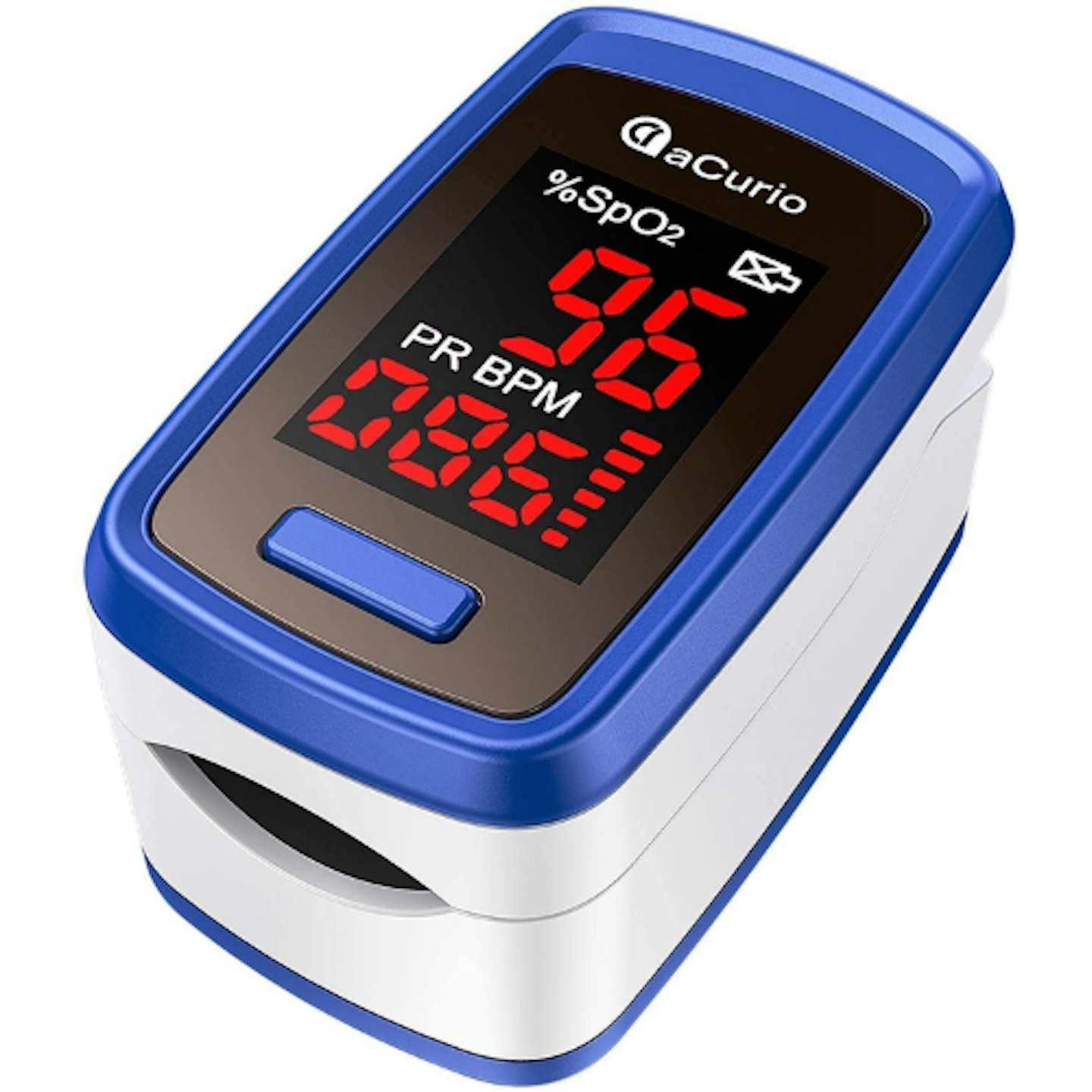 aCurio
aCurioThe aCurio Pulse Oximeter is an important addition to any household. Whether you're checking your own oxygen levels or monitoring a family member, this pulse oximeter provides fast, accurate readings that are essential for peace of mind.
Featuring an ergonomic shape lined with natural latex, it ensures that the fingertip remains comfortable – allowing for blood flow – which results in accurate measurements. As one user notes, "The accuracy is excellent, and I have been checking it against the blood pressure unit I have, which also reads the heartbeat, so I know it is correct."
For families, it’s especially appealing because it is suitable for anyone aged four and up. The simplicity of use is another major selling point as one user states: “Incredibly simple to use. No setup, just insert batteries (not supplied) and it works.” In just eight seconds, you’ll have a reading, and the display features large red numbers that are easy to read at a glance.
In terms of build quality, the aCurio Pulse Oximeter is durable and robust, made from high-density ABS material with an anti-collision design. This makes it particularly suitable for active users or those who want to take it travelling. Its low power consumption also ensures that it lasts a long time, saving you the hassle of frequent battery replacements. Additionally, it has an automatic shutdown function when it doesn't detect a finger, which helps conserve battery life.
It's a valuable tool for quick assessments at home, especially during emergencies. As one user puts it, "Recommended, especially if ill. Could help determine if you need medical assistance or not."
Overall, the aCurio Pulse Oximeter offers a straightforward, practical health monitoring solution. Whether you're concerned about your oxygen levels or simply want to keep track of your fitness, this affordable, easy-to-use device has got you and your loved ones covered.
Pros
- Large font makes it easy for people to read
- Suitable for the whole family
- Fast, accurate readings in just eight seconds
- Ergonomic design with natural latex for comfort and accurate measurements
- Durable with anti-collision design
- Low power consumption and automatic shutdown feature to save battery life
Cons
- Doesn’t come with batteries (requires 2 x AAA)
| SpO2 measurement range: | 70-100% |
| SpO2 accuracy: | +/- 3% |
| PR measurement range: | 30-250bpm |
| Accuracy: | +/- 1bpm |
| Power: | requires two AAA alkaline batteries |
| Dimensions: | 6 x 3.5 x 3.3cm |
36% off
Best pulse oximeter for intuitive display
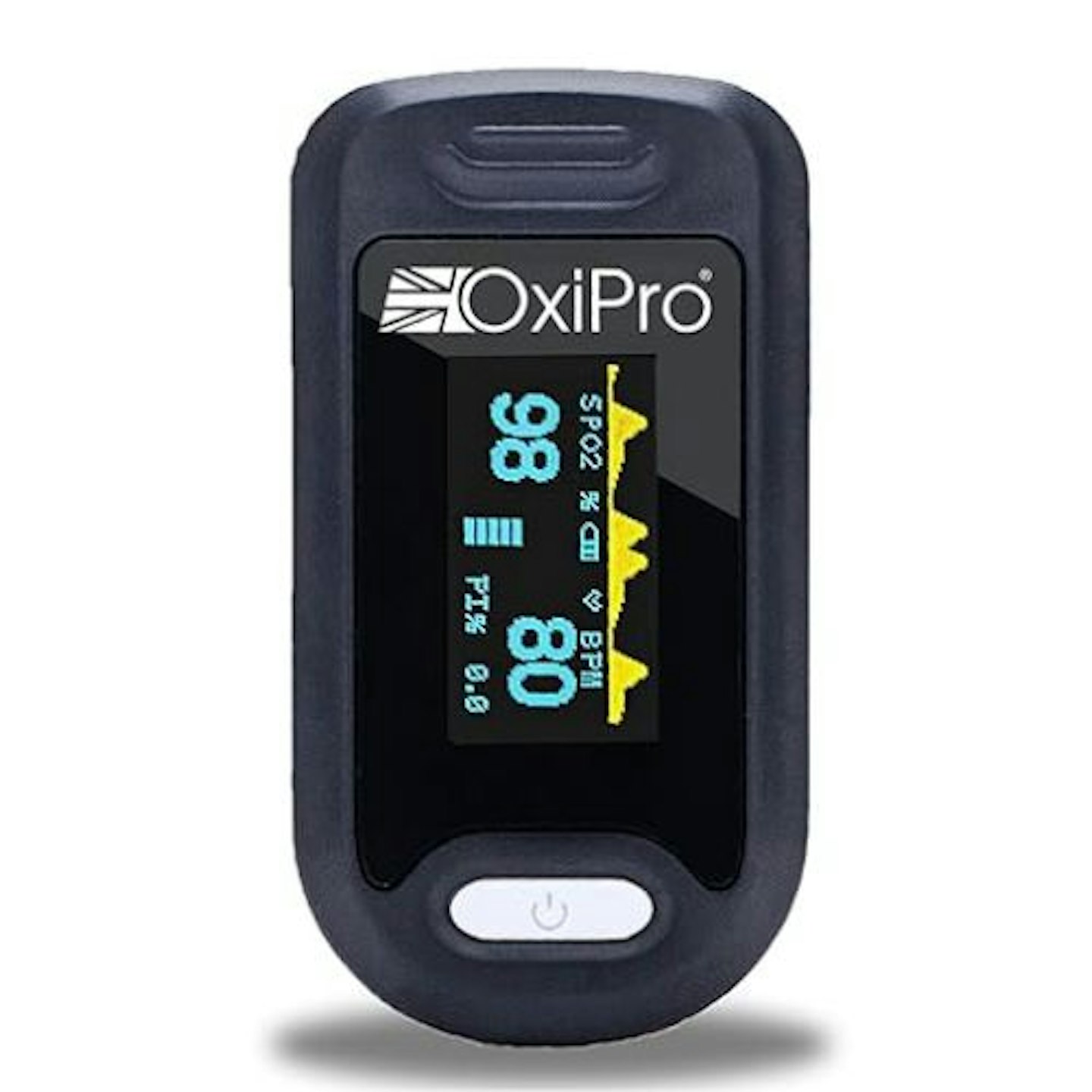 OxiPro
OxiProThe OxiPro OX2 Pulse Oximeter leads the market as the number one bestseller on Amazon. This pulse oximeter offers a user-friendly experience and has several features that make it a top choice for both hospital and home use.
One standout feature is the intuitive display. The OxiPro OX2’s colour screen offers six different display modes, making it easier to differentiate between readings. The display rotates 90°, allowing you to see your results easily from different angles.
Another important feature is the pulse graph, which shows your heart rate pattern. This makes tracking your heart rate more visually informative.
Users have expressed confidence in its accuracy, with one noting, "readings match those recently taken by my local surgery." In addition to monitoring your oxygen saturation levels (SpO2), it also displays the perfusion index, an indicator of pulse strength. The OxiPro OX2 also has an alarm to notify you if your blood oxygen levels drop below a safe threshold, providing extra peace of mind.
With a simple one-button operation, you can quickly take readings without any complicated setup. It also comes with 2 AAA batteries, a lanyard and an instruction manual, making it ready to use right out of the box.
Users have consistently praised the OxiPro OX2's quality. One remarked, "This one feels well made and robust, with a bright and clear display." The solid construction adds to the product's overall durability, with several comments highlighting how the device feels sturdy and dependable.
However, it’s worth noting that some users have reported occasional issues with the device picking up readings. One user mentioned, "I have found that it generally does not pick up a reading at all on children." While this may be a concern for parents, the OxiPro OX2 remains highly regarded for its functionality and ease of use among most adults.
Overall, the OxiPro OX2 Pulse Oximeter stands out as an excellent, reliable and easy-to-use product, making it an ideal choice for anyone needing to monitor their blood oxygen levels or heart rate. Whether you're using it at home or in a clinical setting, this device offers accurate results, a bright and clear display and the quality that OxiPro is known for.
Pros
- Intuitive, easy-to-read colour screen with six display modes
- Rotating display for easy viewing from different angles
- Pulse graph to visualise heart rate patterns
- Simple one-button operation
- Alarm alerts for low blood oxygen levels
- High-quality
Cons
- May struggle to pick up readings on children
| SpO2 measurement range: | Shown to 1% |
| PR measurement range: | Shown to 1bpm |
| Accuracy: | 1% SpO2 Resolution / 2% Accuracy (CE MDD Standard) |
| Power: | 2 x AAA batteries |
| Dimensions: | 5.5 x 3 x 3.5 cm |
Pulse oximeter buyer’s guide
If you have a respiratory condition, heart issues, or are recovering from illness, a pulse oximeter can help monitor your health at home.
Always consult your GP or healthcare provider before using a pulse oximeter for medical decisions.
Here’s a guide to help you choose the right pulse oximeter for your needs:
Generally, a pulse oximeter has a clear, straightforward controls. Devices with a single-button function are the most user-friendly.
Look for a device with a large, high-contrast display that’s easy to read in different lighting conditions.
Ensure the oximeter fits comfortably on your finger without pinching or slipping off. Some models are specifically designed for larger or smaller fingers.
Check if the device is certified or approved for medical use (e.g., CE-marked in the UK). This ensures accurate and reliable readings.
Advanced models may show additional information like pulse waveforms or perfusion index (PI), which can be helpful for more detailed monitoring. Some pulse oximeters sync with your smartphone, allowing you to track your readings over time. This feature can be helpful if you’re sharing data with a healthcare provider. If you prefer simplicity, choose a basic model without connectivity options.
Choose an oximeter with a long-lasting battery to reduce frequent recharging or replacements. Also, consider whether the device uses replaceable batteries (e.g., AAA) or a rechargeable option. Finally, ensure it has a low battery indicator so you're not caught short with a dead device.
If you plan on using an oximeter on the go, choose a model that is easy to carry and comes with a protective case.
Some models are water-resistant, providing extra protection against accidental splashes.
Basic pulse oximeters are available from around £20-£50. Advanced models with additional features may cost more.
Ask the expert about NHS-approved oximeters
We spoke to Lindsey Ulin, Physician from Brigham and Women's hospital, to get the answers to all the important questions about pulse oximeters.
NHS-approved pulse oximeter FAQs
What is an oximeter?
If you're unsure whether or not you need to use an NHS-approved pulse oximeter, you should always contact your GP or a health professional. As an oximeter is a tool used to help with the diagnosis of COVID-19, monitoring sleep apnoea and more, it's essential that you find out what risks most apply to you and discuss any concerns that you might have.
According to the NHS website, "A pulse oximeter is a small medical device that is put on the tip of the finger, to check someone's oxygen levels. Pulse oximeters measure blood oxygen levels by transmitting light through a finger – they are more accurate than smartwatches or phones, which make less accurate readings by reflecting light off the skin."
What to look for in an oximeter
When you come to purchase an oximeter, it's a good idea to look for one that is NHS approved and comes from a reputable retailer. A clear, easy-to read screen is important - the last thing you want to be doing is squinting or trying to find your glasses to read the numbers.
Think about what you need it for - is it just to monitor blood oxygen levels, or do you want a device that also records heart rate, blood pressure and more?
How to use a pulse oximeter
Ulin says: "Pulse oximeters are easy to use. Before your first use, see if the device needs batteries which may not be included in the packaging. First, clean the device with a soft cloth or a cotton swab with rubbing alcohol. Place your index finger into the finger pad in the device with your fingernail facing up. Wait for the pulse oximeter to display the two numbers on its screen."
What finger should I put there oximeter on?
"Place the device on your index finger. If numbers do not appear after a few moments or the numbers are abnormal, try again on your middle, ring, or pinky fingers. Clean the device again after using it."
Please note: Pulse oximeters may not be accurate for people with dark skin tones, or who have nail polish on, cold skin, poor circulation, or tattoos near the sensors.
Are oximeters accurate?
Pulse oximeters used in medical settings or hospitals are high-quality and likely to give you the most accurate reading. Pulse oximeters are available for sale in your local chemist or online for use at home, and while they will record your oxygen levels, some can be inaccurate or give poor readings if used incorrectly.
It is important to invest in one that has been NHS-approved, comes from a reputable retailer or has been recognised for its quality. While it may not be necessary for everyone, this gadget could be used by individuals with underlying respiratory issues who may want to monitor or assess the severity of attacks or physically active people who experience regular drops in oxygen levels.
Ulin recommends checking the accuracy of your home device with your GP: "Consider bringing your pulse oximeter to your next doctor's appointment to compare its reading with the monitor in the office."
What are the two readings on a pulse oximeter?
"Pulse oximeters display two numbers, one is the heart rate which usually has a PR standing for pulse rate and will show how many times your heart beats per minute. The other number is blood oxygen saturation which appears next to SpO2 % and measures the amount of oxygen carried by your red blood cells."
What should your oxygen levels be?
"Oxygen saturation levels of 95 percent and above are normal for most people. However, if you have certain chronic conditions like chronic obstructive pulmonary disease (COPD) or sleep apnea, your normal oxygen level may be closer to 90 percent. Check with your healthcare provider if you are not sure what your normal level should be."
What if your oxygen levels are too low?
"Seek medical attention immediately if your oxygenation level on your pulse oximeter is below 90 percent. Oxygen levels of 91 to 94 percent may be a sign of a concerning medical problem even before symptoms start and warrant evaluation by a healthcare provider such as your GP nurse."
How to use an oximeter at home:
Want to use an oximeter from the comfort of your own home? You can measure your pulse rate and oxygen levels by clipping the oximeter to your fingertip. Once it's attached to you securely, switch it on and wait a short time for the results to show.
If you're still unsure how to get this device to work, the NHS has pulled together a six-minute video to show you how to use a pulse oximeter at home. We love that this video takes you step-by-step on how you can monitor your readings if you've been asked to use one by your GP or health professional.
You can also track your healthy with a smartwatch device.
How to use a oximeter
• Wash your hands before using.
• Make sure the finger you are going to use does not have a fake nail or nail varnish on it.
• Sit down comfortably. Make sure your hand is warm to the touch then rest it on your chest for five minutes.
• Switch the pulse oximeter on.
• Then attach the clip to the finger next to your thumb, or your middle finger.
• Keep still for at least a minute. If the numbers keep fluctuating, you may need to be still for longer. Once the numbers remain steady, you have your reading.
• Record the two numbers you see. One is your oxygen saturation level, and the other is your heart rate. Each will be clearly labelled on the device.
• Remove the device from your finger and store it in a safe place.
• Do you have darker skin tone? Only 1 in 3 oximeters give accurate readings on darker skin so make sure your one does.
• Keep a log of your readings to discuss with your healthcare provider if needed.
Lindsey Ulin, M.D. is an internal medicine resident physician and PCP at Brigham and Women's Hospital, affiliated with Harvard Medical School.
Eleanor Weaver is the Deputy Homes & Garden Product Editor for Yours, specialising in home décor, furnishings and appliances. Having worked commercially on Yours magazine and Yours.co.uk for the past six years, she's previously hosted Yours Live events and loves looking for home inspiration online.






